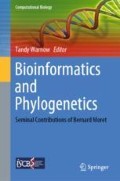Abstract
A supertree method is a form of meta-analysis. It combines phylogenetic tree estimates, which typically include only a subset of the species of interest, into a single tree that includes every species found in any input tree. These methods are usually applied to phylogenetic estimates that only have taxonomic labels at their leaves. Taxonomies are another source of information about phylogenetic relationships. They usually convey names for groups of species in addition to species names. If a taxonomy places every species, then its phylogenetic information can be fully expressed as a tree. Such a taxonomy could easily serve as one of the inputs to a supertree method. However, most taxonomies contain incertae sedis taxa, which are species or groups of species that have an uncertain placement within the taxonomic hierarchy. Here, we review some principles of building trees from splits and describe a supertree method that is able to handle incertae sedis taxa without losing taxon names.
Access this chapter
Tax calculation will be finalised at checkout
Purchases are for personal use only
References
Adams III, E.N.: Consensus techniques and the comparison of taxonomic trees. Syst. Biol. 21(4), 390–397 (1972). https://doi.org/10.1093/sysbio/21.4.390.
Aho, A.V., Sagiv, Y., Szymanski, T.G., Ullman, J.D.: Inferring a tree from lowest common ancestors with an application to the optimization of relational expressions. SIAM J. Comput. 10(3), 405–421 (1981)
Baum, B.R.: Combining trees as a way of combining data sets for phylogenetic inference, and the desirability of combining gene trees. Taxon 41, 3–10 (1992)
de Queiroz, K.: Nodes, branches, and phylogenetic definitions. Syst. Biol. 62(4), 625–632 (2013). https://doi.org/10.1093/sysbio/syt027. https://doi.org/10.1093/sysbio/syt027
Dress, A., Huber, K.T., Koolen, J., Moulton, V., Spillner, A.: Basic Phylogenetic Combinatorics. Cambridge University Press (2012)
Hinchliff, C.E., Smith, S.A., Allman, J.F., Burleigh, J.G., Chaudhary, R., Coghill, L.M., Crandall, K.A., Deng, J., Drew, B.T., Gazis, R., Gude, K., Hibbett, D.S., Katz, L.A., Laughinghouse, H.D., McTavish, E.J., Midford, P.E., Owen, C.L., Ree, R.H., Rees, J.A., Soltis, D.E., Williams, T., Cranston, K.A.: Synthesis of phylogeny and taxonomy into a comprehensive tree of life. Proc. Natl. Acad. Sci. 112(41), 12,764–12,769 (2015). https://doi.org/10.1073/pnas.1423041112. http://www.pnas.org/content/112/41/12764.abstract
Hörandl, E., Stuessy, T.F.: Paraphyletic groups as natural units of biological classification. Taxon 59(6), 1641–1653 (2010). http://www.jstor.org/stable/41059863
McTavish, E.J., Hinchliff, C.E., Allman, J.F., Brown, J.W., Cranston, K.A., Holder, M.T., Rees, J.A., Smith, S.A.: Phylesystem: a git-based data store for community-curated phylogenetic estimates. Bioinformatics btv276 (2015)
Ragan, M.A.: Phylogenetic inference based on matrix representation of trees. Mol. Phylogenet. Evol. 1(1), 53–58 (1992)
Redelings, B.D., Holder, M.T.: A supertree pipeline for summarizing phylogenetic and taxonomic information for millions of species. PeerJ 5, e3058 (2017)
Rees, J.A., Cranston, K.: Automated assembly of a reference taxonomy for phylogenetic data synthesis. Biodivers. Data J. 5(5), e12581 (2017)
Wilkinson, M.: Common cladistic information and its consensus representation: reduced adams and reduced cladistic consensus trees and profiles. Syst. Biol. 43(3), 343–368 (1994)
Acknowledgements
The authors thank Dr. Karen Cranston for comments and the NSF (awards 1759838 and 1208393) for funding. MTH would like to thank Dr. Bernard Moret. Dr. Moret’s leadership of the CIPRES project was crucial to MTH’s early career, and Dr. Moret’s career consistently served as an inspiring example of integrating the discipline of computer science with evolutionary biology.
Author information
Authors and Affiliations
Corresponding author
Editor information
Editors and Affiliations
Rights and permissions
Copyright information
© 2019 Springer Nature Switzerland AG
About this chapter
Cite this chapter
Redelings, B.D., Holder, M.T. (2019). Taxonomic Supertree Construction with Incertae sedis Taxa. In: Warnow, T. (eds) Bioinformatics and Phylogenetics. Computational Biology, vol 29. Springer, Cham. https://doi.org/10.1007/978-3-030-10837-3_7
Download citation
DOI: https://doi.org/10.1007/978-3-030-10837-3_7
Published:
Publisher Name: Springer, Cham
Print ISBN: 978-3-030-10836-6
Online ISBN: 978-3-030-10837-3
eBook Packages: Computer ScienceComputer Science (R0)

